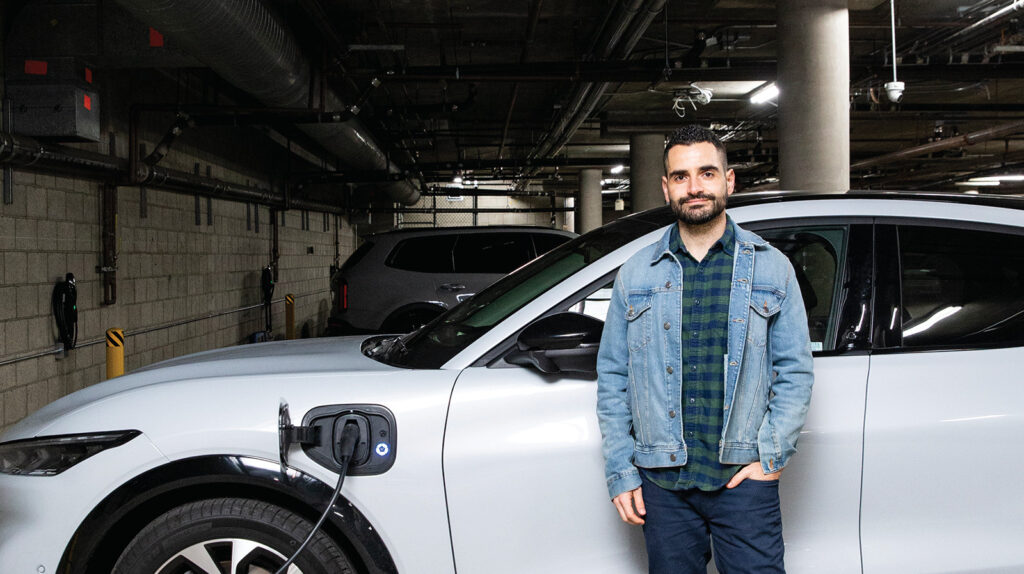
Eric Thomasian stands in front of his electric vehicle in the parking garage where it all started.
(Chris Mortenson/Staff)
By Morgan Owen
Every year, electric vehicles become more popular. As the charging infrastructure grows and pricing becomes more affordable, more Americans are buying into the idea of electric vehicles. But for Angelenos who live in rented apartment complexes or own a condo, the logistics of installing an electric charger poses a very real barrier to adoption.
Two years ago, Eric Thomasian approached the governing board in his residential building with a request to install an electric vehicle charger in the building’s garage. The board approved Thomasian’s request, but it got them thinking about the broader implications of Thomasian’s request and the infrastructure of their garage at 13173 Pacific Promenade.
“Not only does it future proof the building, but as more residents demand chargers, the board is in a situation where they can’t say no, by law,” Thomasian says. “So, they better get ahead of that (because) with everyone installing their own, it’s just not scalable. It can lead to power outages and all sorts of (issues).”
Both the board and Thomasian were sure other requests would follow. After all, their building is in Playa Vista, where electric vehicles are popular among residents employed in the technology industry.
To install individual chargers for every person in the building who requests it wasn’t as simple as plugging it into an existing outlet; it would require the owner of each unit to hire an electrician to install wiring from their parking spot to the building’s electrical room. In the electrical room, a switch would need to be installed with all the necessary equipment and the building’s infrastructure would reach its limit far before demands were met.
When the contractor Thomasian hired to install his EV charger told him about a program through LADWP that would allow the entire building to subsidize the cost of installing chargers, the board jumped at the opportunity.
The program, titled the Commercial EV Charging Station Rebate Program, was created by LADWP to incentivize the installation of electric vehicle charging equipment. Before applying, applicants must submit electrical and infrastructure plans along with a more general application.
“The application process through LADWP was straightforward, but there are more applicants than funding, so it goes to a lottery. And we, fortunately, won,” Thomasian says.
The grant LADWP awarded Thomasian’s building was for $160,000. With that, Thomasian and the board were able to install 40 chargers in the building’s two garages. Now, each of the building’s 81 units has access to at least one electric vehicle charging station.
Residents pay for the cost of charging through their HOA, and the board gets to set the price of how much charging costs per kilowatt-hour. As of right now, residents pay only 25 cents compared to public chargers, which often cost 40 to 50 cents per kilowatt hour. In the future, Thomasian says he and the board plan to create a time-based surge during popular times to encourage residents to charge throughout the night.
Thomasian explains the feature that makes it so easy for the building to keep track of who is charging at what times is the digital infrastructure that came along with the chargers. Because they received Tesla-branded chargers through the LADWP grant, Tesla sets each resident up with an account, charging them directly before reimbursing the building’s HOA. The chargers are universally compatible.
The building’s HOA president, Ken Dauer, says residents are loving the new feature. Some residents, he says, are even trading in their gas-powered cars for electric ones.
“The homeowners are very satisfied, and they are very excited. Homeowners are saying this is a great way to increase their property value, whether (they) get their own car, sell (their unit), or lease (their) unit to a tenant. Now there is interest. It’s a great property value enhancer.” Dauer says.
Thomasian says installing the electric chargers is a major asset to the building as we move into a new era of technology. He thinks that, as electric vehicles become increasingly popular, having those chargers will become an increasingly important incentive in multifamily housing.
Thomasian says he hopes that this story empowers other buildings’ staff in Playa Vista to take the same step forward. As he put it, Playa Vista is an affluent community where many people have electric cars, but right now, there isn’t a solution. This, Thomasian believes, is one way to tackle that problem.
Leave a Reply